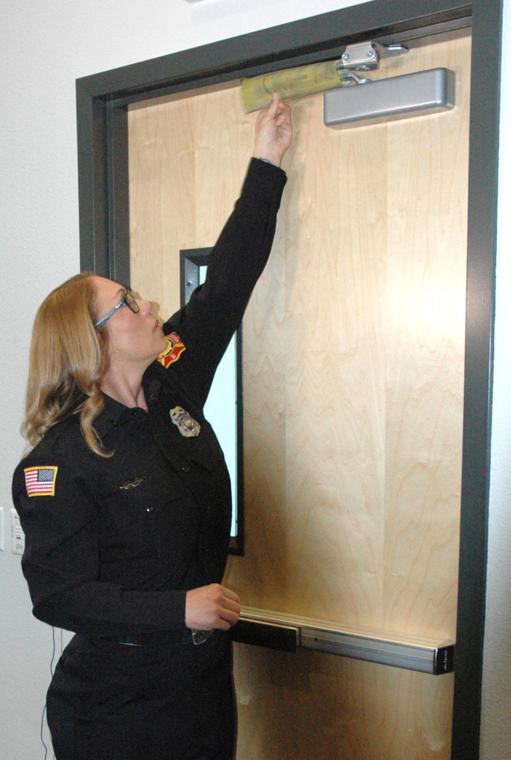When I first started seeing news reports about decommissioned fire hoses being used to secure classroom doors, it was so disappointing and depressing that I just deleted the Google Alert and moved on. But enough people have asked me about this security method, that I guess I have to respond.
First, here’s one of the stories from KGUNTV:
 There is a print article from the Glendale Star here which includes the photo to the right. In both stories, firefighters promote the use of old fire hoses cut into short pieces, to secure classroom doors by sliding them over the closer arm.
There is a print article from the Glendale Star here which includes the photo to the right. In both stories, firefighters promote the use of old fire hoses cut into short pieces, to secure classroom doors by sliding them over the closer arm.
I do realize today is Wordless Wednesday, but even though the idea of firefighters promoting a security method that restricts egress leaves me wordless, I have a few comments.
1) The percentage of classroom doors with a parallel arm closer is very low. Many classroom doors swing in, and most classroom doors across the country do not have closers because current codes do not require most classroom doors to be self-closing. If schools think they can get 100 sleeves from the fire department and their problem is solved, what they may actually be getting is a false sense of security.
2) In the photo to the right, the door is equipped with panic hardware. This indicates that it’s probably serving an occupant load of 50 people or more and should allow free and immediate egress. If this panic hardware is latched and the outside lever locked, it will provide far superior security to a piece of fire hose, as will a traditional lockset. In the video you can see that the door still opens partway when the sleeve is installed.
3) During an active assailant situation, a teacher will have to approach the door and reach up to install the sleeve. In the school shootings in Parkland and Santa Fe, students and teachers were injured or killed while trying to lock or barricade the classroom door.
4) If an unauthorized person uses this sleeve to “lock” the door and secure the room to commit an assault, sexual assault, or other crime, the sleeve can not be removed from the outside by a teacher or emergency responder. The 2018 model codes require classroom doors to be able to be unlocked from the outside with a key or other approved means. The fire hose method does not meet this code requirement, not to mention the egress or accessibility requirements.
5) As a last resort, I support using whatever is on hand to secure/barricade the door. AS A LAST RESORT. But if we have time to look at the school’s current situation and plan the response – is this REALLY the best we can do?
Firefighters – I still love you, but this is not the best way to secure a classroom door. 🙁
Photo: Cary Hines, Glendale Star
You need to login or register to bookmark/favorite this content.





I’m with you. Most schools already have the means to secure their classroom doors installed. Many just need to update their policies and procedures as well as enforcing rules such as not propping open exterior doors because the teacher can’t be bothered to let a child in that needs the restroom during recess.
Thank you for your clarification. Being new to the door industry, I always appreciate your perspective and explanations.
Let me let you in on a not-so-secret secret. One’s jaw will
hit the floor in awe of Ms. Greene’s wisdom, experience in
this field !!
Doing a great service Lori, keep it up
While I get that someone could utilize some method to commit a crime within the classroom, a simple wood chock could easily do the same. If someone has the intent to “secure the room to commit an assault, sexual assault, or other crime” they’ll ignore all the rules and do it. We are not providing financially realistic devices to retrofit our existing schools in an immediate manner. Like NFPA 101, we need to look at addressing one emergency at a time.
Can we not trust 95% of our students or teachers to actuate a lock from the inside only when appropriate? Can we not treat that locking device like the fire alarm pull stations. (Ie: severe penalties for any infractions)
How long will we spend devising and paying for locks that can be locked remotely, and only opened by officials at the right time? How many more of these tragedies will occur before that happens? How many more fatal school fire will occur? Most schools built in the last 50 years have been designed for egress and compartmentalization, much greater survival, never mind those that are sprinklered.
While the firehose solution seems pretty rudimentary, it would likely slow an outside threat and if placed there for another nefarious reason, any kid with a chair could remove it. If it could be removed by anyone outside, it would be useless against the active shooter threat. If it can only be removed by someone from outside who is not a threat, then it costs time and money and will not be utilized soon enough to stop the next tragedy from occurring somewhere.
Hi Adam –
Thank you for sharing your insight on this issue – I really appreciate it. Fire is only one of the considerations, but fires in schools are MUCH more common than active shooters. Of course, active shooters in schools have the potential to inflict a lot of damage in a short amount of time, and every injury or death in a school shooting is one too many. With that said, there are ways to deter or prevent access without obstructing egress.
I’m not talking about every school district paying to upgrade to electrified locks. Most classroom doors already have locksets. If those existing locks are used correctly, they can provide a sufficient level of security. The glazing adjacent to the locks must also be addressed to delay access through the glass to the interior lever, but that can be done fairly inexpensively and without compromising life safety. Keying is another factor – teachers, staff, and substitute teachers must have keys and must be able to lock their doors quickly. Again, not expensive and mostly procedural.
With regard to unauthorized lockdown, kids can and will fool around with locks or other security devices. Not all kids, of course. But in the “Olden Days” when I was in junior high, I remember one of the kids (girls!) in my home ec class locking out our teacher using the thumbturn on the classroom side of the door. It was just a prank – no harm done, other than Mrs. Cross crying in the hallway, but the hardware industry later introduced the classroom function lock that could only be locked with a key in the outside lever. After Columbine, the classroom security lock was introduced, which allows the door to be locked from either side with a key. These changes were driven by the needs of schools.
Each lock function has pros and cons, and it’s up to each district to decide works best for them. But the potential for unauthorized lockdown should be a huge consideration. Many people don’t realize how many crimes are committed in schools – in some cases serious crimes. If you want more information on school crime, check out this publication: https://nces.ed.gov/pubsearch/pubsinfo.asp?pubid=2018036. One statistic from the report that caught my eye was this: “In 2016, among students ages 12–18, there were about 749,400 victimizations (theft and non-fatal violent victimization) at school.” During the same period, the FBI reports that there were 20 active shooter incidents in the US, with 3 of those occurring in schools (1 of the 3 occurred outside of the prom). As I have said many times, I am not in any way trying to minimize the importance of any shooting, but the frequency of other crimes in schools can not be ignored.
Using a security method that deters or prevents egress is not code-compliant. Authorized access from the outside and free egress from the inside are critical. As a last resort, anything goes. But when we have time to pre-plan, why would we not consider all aspects – security, egress/evacuation, fire protection, accessibility, etc.?
– Lori
I understand that many other things happen besides firs and active shooter situations, but saying “it isn’t code compliant” does not make us part of the solution. We must look at the reasons for our particular codes and determine if they’re still fully relevant or if the current issue supersedes previous issues?
While we may still have more fires in schools by numbers, we need to evaluate those stats critically. As a career firefighter/chief officer with over 30 years in the fire service I can tell you that our national incident reporting system allows for large numbers that lack detail. Every fire in a school includes: wastepaper basket fires, fires that are out on arrival, fires that occur after hours, and of course those more significant fires. Look at the statistics on injuries or fatalities in school fire incidents and I’m willing to bet they are far fewer than those caused by the few (in number, not marginalizing these tragedies) active shooter incidents.
I’m not supporting any fire department making or suggesting devices that can be used to hamper egress, but I’m also not ready to cite schools who have used ingenuity to create temporary solutions to the potential threat. Locksets that utilize keys are better than nothing but do little if they can’t be kept secure. Having master keys and numerous individual keys make it fairly simple for someone from the inside to obtain them, quickly making a keyed lockset another false sense of security measure.
I do think this site is doing a great service keeping everyone up to date on the topic, if this was a simple problem we wouldn’t need to see all these homemade solutions.
Hi Adam –
During the 2018 model code cycle, classroom security was a huge topic of conversation. I think that if the codes were not relevant or needed to be relaxed/changed because of current events, it would have happened during that cycle. There were numerous opportunities for modifications, but instead of reducing the requirements that have been part of the model codes for over 30 years, all of those requirements remained and some new requirements were added – including the need to be able to unlock a locked classroom door from the outside using a key or other approved means. This is also recommended by the National Association of State Fire Marshals. As far as I know, an active shooter has never used a master key during a school shooting, but I do know of school shootings where the assailant barricaded himself inside with the victims and delayed law enforcement response.
Thanks for the compliment on the site – I think we both have students’ and teachers’ security and safety in mind.
– Lori
Our school doors swing in. All you need is a simple wood wedge at the bottom. Done.
Lori,
As a Fire Marshal I am ticked off about this and very embarrassed. Through my 38 years in the fire service I’ve always known the firefighters who were always trying to think of new things and new ways of doing things but I’m at a loss for this one. Although they acted in good faith, they may have opened themselves and their department and city up to a huge lawsuit. Not to mention their Fire Marshal or Chief should have stepped up and said that these devices are NOT CODE COMPLIANT!!! I can see the headlines in their local paper…”Student killed trying to deploy device obtained from the local fire department”. We have enough problems from the uninformed public dealing with this issue that we don’t need to complicate this from the fire service as well. Thanks Lori.
Sorry if you got this yesterday but I wasn’t sure if my response got through.
Hi Kevin –
Phew! At first I thought you were ticked off at me! 🙂
I agree with the potential for headlines, lawsuits, etc. It’s just so weird to me that when fire marshals DO stand up and say “this is not code-compliant” about any of the inventive methods of securing doors, they’re the power-hungry bad guys enforcing an ancient code that is perceived to be unnecessary now that we are dealing with guns instead of fires. Fires still happen – way more often than active shooters in schools. I know everyone’s heart is in the right place here, but many people are not looking at the big picture.
– Lori
NEVER!!! Keep up the FANTASTIC work you do!!!
In addition to all the excellent points mentioned so far, I also question how they are decontaminating these hoses to ensure all the toxins and carcinogens have been removed (assuming these have been used on the fire ground or in training). I appreciate the thought and the effort these firefighters put into the issue but did they carry out due diligence and cover/consider all aspects of the use of these hoses.
What size firehose? In researching this I see different size “OLD/retired” fire hoses… which is needed?
Hi Nancy –
I don’t know what size hose is used. This method of locking classroom doors is not a good solution for a lot of reasons.
– Lori
Ms. Greene,
You are so kind and diplomatic !!! 🙂 The previous poster would have you by her
question, assist her in enablement and furthing of this problem… I might have
put it to her as “Please stop and think for a minute what you’re asking…”, then
if a lightbulb didn’t go off, so to speak, I’d take time and reason with them and
by doing so, hopefully they would have a grasp of the gravity.
Ms. Greene, I do appreciate your talent for brevity. as well. 🙂
Me thinks this {generic} “Fire Safety Professional” could use some “Re-Ed-yuh-muh-kaysh-kun”…. hehehehe
Unfortunately the link to the articla no longer works.. cheap newpaper
must have run out of hard disk space..
Thanks for letting me know! The link is working for me now…maybe it was just a temporary problem.
– Lori
¯\_(ツ)_/¯
Just because an active shooter has never used a key to gain entry does NOT mean that it will never happen. Better to be pro-active than reactive. The perfect system might not ever be invented that would satisfy all concerns. I thought most everyone knew that locks are only good for keeping out honest people. I wish I had the perfect answer, but I will not give up.
In several of the most recent school shootings they found that the classroom either had no door lock or could only be locked from the outside.
There had been plans to remedy this but due to budget constraints had not yet happened. Our school doors open outward because the fire marshal has determined that this is the safest and fasted way for egress during a fire. Could the sleeves be provided as a means of last resort? They are better than nothing, right?
Would cleaning the hose in advance make it acceptable for that 6” length of hose to be located in the classroom, especially since it is not handled regularly?
I’m a teacher. I bought a piece of firehose. I also bought zip ties for the same purpose (to immobilize the arms of the door closing device.) I also have a can of Bear Spray in my desk drawer.
If the school district would authorize it, I would complete training and carry a concealed handgun to protect my students and paraprofessionals.
I do not want to be a helpless victim.
Hi Steve –
I sincerely wish that all teachers had classroom doors and locks that they could rely on, but I know that’s not the case in every district. Hopefully someday, as the 2027 codes will require classrooms and other spaces within schools to have doors that can be locked from the inside, while still allowing authorized access and free egress.
– Lori